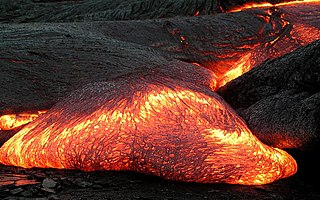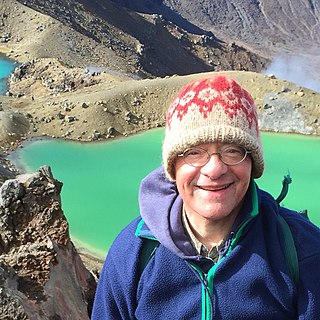
Magma is the molten or semi-molten natural material from which all igneous rocks are formed. Magma is found beneath the surface of the Earth, and evidence of magmatism has also been discovered on other terrestrial planets and some natural satellites. Besides molten rock, magma may also contain suspended crystals and gas bubbles.

A rock is any naturally occurring solid mass or aggregate of minerals or mineraloid matter. It is categorized by the minerals included, its chemical composition and the way in which it is formed. Rocks form the Earth's outer solid layer, the crust, and most of its interior, except for the liquid outer core and pockets of magma in the asthenosphere.

Andesite is an extrusive volcanic rock of intermediate composition. In a general sense, it is the intermediate type between basalt and rhyolite. It is fine-grained (aphanitic) to porphyritic in texture, and is composed predominantly of sodium-rich plagioclase plus pyroxene or hornblende.

Volcanic rock is a rock formed from lava erupted from a volcano. In other words, it differs from other igneous rock by being of volcanic origin. Like all rock types, the concept of volcanic rock is artificial, and in nature volcanic rocks grade into hypabyssal and metamorphic rocks and constitute an important element of some sediments and sedimentary rocks. For these reasons, in geology, volcanics and shallow hypabyssal rocks are not always treated as distinct. In the context of Precambrian shield geology, the term "volcanic" is often applied to what are strictly metavolcanic rocks. Volcanic rocks and sediment that form from magma erupted into the air are called "volcaniclastics," and these are technically sedimentary rocks.

Petrology is the branch of geology that studies rocks and the conditions under which they form. Petrology has three subdivisions: igneous, metamorphic, and sedimentary petrology. Igneous and metamorphic petrology are commonly taught together because they both contain heavy use of chemistry, chemical methods, and phase diagrams. Sedimentary petrology is, on the other hand, commonly taught together with stratigraphy because it deals with the processes that form sedimentary rock.
Within the field of geology, Bowen's reaction series is the work of the petrologist Norman L. Bowen, who summarized, based on experiments and observations of natural rocks, the sequence of crystallization of common silicate minerals from typical basaltic magma undergoing fractional crystallization. Bowen's reaction series is able to explain why certain types of minerals tend to be found together while others are almost never associated with one another. He experimented in the early 1900s with powdered rock material that was heated until it melted and then allowed to cool to a target temperature whereupon he observed the types of minerals that formed in the rocks produced. He repeated this process with progressively cooler temperatures and the results he obtained led him to formulate his reaction series which is still accepted today as the idealized progression of minerals produced by cooling basaltic magma that undergoes fractional crystallization. Based upon Bowen's work, one can infer from the minerals present in a rock the relative conditions under which the material had formed.

The three main ways terrestrial rocks are formed:

Ultramafic rocks are igneous and meta-igneous rocks with a very low silica content, generally >18% MgO, high FeO, low potassium, and are composed of usually greater than 90% mafic minerals. The Earth's mantle is composed of ultramafic rocks. Ultrabasic is a more inclusive term that includes igneous rocks with low silica content that may not be extremely enriched in Fe and Mg, such as carbonatites and ultrapotassic igneous rocks.

Komatiite is a type of ultramafic mantle-derived volcanic rock defined as having crystallised from a lava of at least 18 wt% MgO. Komatiites have low silicon, potassium and aluminium, and high to extremely high magnesium content. Komatiite was named for its type locality along the Komati River in South Africa, and frequently displays spinifex texture composed of large dendritic plates of olivine and pyroxene.
Rock microstructure includes the texture of a rock and the small scale rock structures. The words "texture" and "microstructure" are interchangeable, with the latter preferred in modern geological literature. However, texture is still acceptable because it is a useful means of identifying the origin of rocks, how they formed, and their appearance.

A layered intrusion is a large sill-like body of igneous rock which exhibits vertical layering or differences in composition and texture. These intrusions can be many kilometres in area covering from around 100 km2 (39 sq mi) to over 50,000 km2 (19,000 sq mi) and several hundred metres to over one kilometre (3,300 ft) in thickness. While most layered intrusions are Archean to Proterozoic in age, they may be any age such as the Cenozoic Skaergaard intrusion of east Greenland or the Rum layered intrusion in Scotland. Although most are ultramafic to mafic in composition, the Ilimaussaq intrusive complex of Greenland is an alkalic intrusion.

Cumulate rocks are igneous rocks formed by the accumulation of crystals from a magma either by settling or floating. Cumulate rocks are named according to their texture; cumulate texture is diagnostic of the conditions of formation of this group of igneous rocks. Cumulates can be deposited on top of other older cumulates of different composition and colour, typically giving the cumulate rock a layered or banded appearance.
In geology, igneous differentiation, or magmatic differentiation, is an umbrella term for the various processes by which magmas undergo bulk chemical change during the partial melting process, cooling, emplacement, or eruption. The sequence of magmas produced by igneous differentiation is known as a magma series.

Fractional crystallization, or crystal fractionation, is one of the most important geochemical and physical processes operating within crust and mantle of a rocky planetary body, such as the Earth. It is important in the formation of igneous rocks because it is one of the main processes of magmatic differentiation. Fractional crystallization is also important in the formation of sedimentary evaporite rocks.

In geology, an igneous intrusion is a body of intrusive igneous rock that forms by crystallization of magma slowly cooling below the surface of the Earth. Intrusions have a wide variety of forms and compositions, illustrated by examples like the Palisades Sill of New York and New Jersey; the Henry Mountains of Utah; the Bushveld Igneous Complex of South Africa; Shiprock in New Mexico; the Ardnamurchan intrusion in Scotland; and the Sierra Nevada Batholith of California.
Igneous petrology is the study of igneous rocks—those that are formed from magma. As a branch of geology, igneous petrology is closely related to volcanology, tectonophysics, and petrology in general. The modern study of igneous rocks utilizes a number of techniques, some of them developed in the fields of chemistry, physics, or other earth sciences. Petrography, crystallography, and isotopic studies are common methods used in igneous petrology.

Igneous rock, or magmatic rock, is one of the three main rock types, the others being sedimentary and metamorphic. Igneous rock is formed through the cooling and solidification of magma or lava.

Mark S. Ghiorso is an American geochemist who resides in Seattle, Washington. He is best known for creating MELTS, a software tool for thermodynamic modeling of phase equilibria in magmatic systems.
The lower oceanic crust is the lower part of the oceanic crust and represents the major part of it. It is generally located 4–8 km below the ocean floor and the major lithologies are mafic which derive from melts rising from the earth's mantle. This part of the oceanic crust is an important zone for processes such as melt accumulation and melt modification. And the recycling of this part of the oceanic crust, together with the upper mantle has been suggested as a significant source component for tholeiitic magmas in Hawaiian volcanoes. Although the lower oceanic crust builds the link between the mantle and the MORB, and can't be neglected for the understanding of MORB evolution, the complex processes operating in this zone remain unclear and there is an ongoing debate in Earth Sciences about this.

A crystal mush is magma that contains a significant amount of crystals suspended in the liquid phase (melt). As the crystal fraction makes up less than half of the volume, there is no rigid large-scale three-dimensional network as in solids. As such, their rheological behavior mirrors that of absolute liquids. Within a single crystal mush, there is grading to a higher solid fraction towards the margins of the pluton while the liquid fraction increases towards the uppermost portions, forming a liquid lens at the top. Furthermore, depending on depth of placement crystal mushes are likely to contain a larger portion of crystals at greater depth in the crust than at shallower depth, as melting occurs from the adiabatic decompression of the magma as it rises, this is particularly the case for mid-oceanic ridges.














